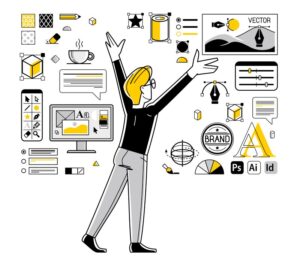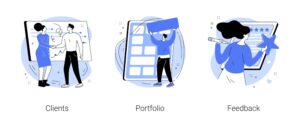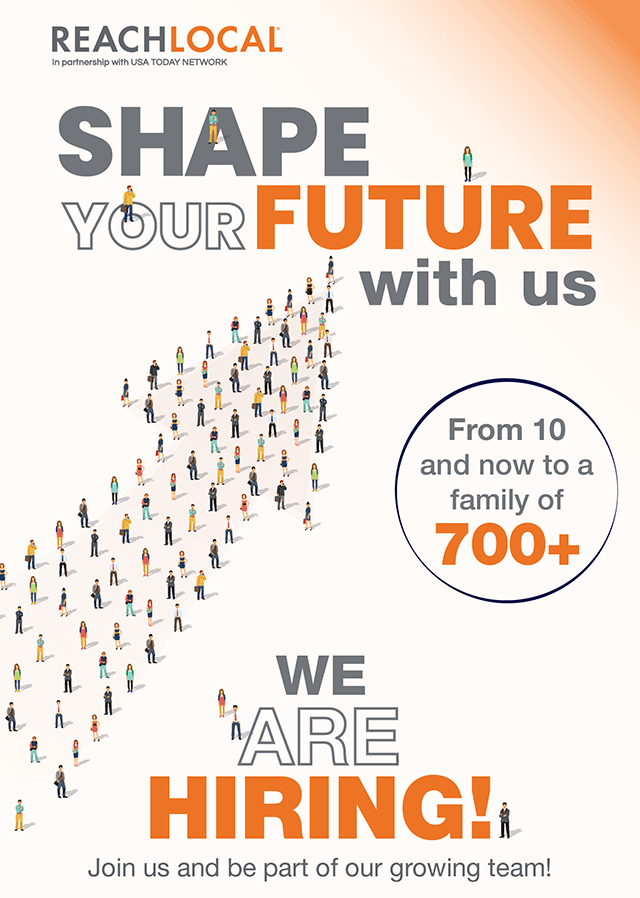The Importance of a Portfolio in Securing a Graphics & Imaging Job
How important is a graphic design portfolio for job seekers?
The world is traveling quickly, not at the speed of light, but rather at the speed of photons. Just kidding! The amazing Eminem song’s line, “No matter how many fish in the sea, it’d be so empty without me,” is the approach that should be taken while creating a portfolio, YES PORTFOLIO for Indeed. Let’s dive in deeper with a few subtle examples of twists and turns. You will eventually become aware of every ounce of conviction that is displayed textually. Here!
The word “portfolio” entered the English language in the late 18th century, The prefix “porta” means “to carry”, and “foglio” means “sheet” or “leaf.”
In the context of art and design, a portfolio originally referred to a portable case or folder containing an Image/Graphic designer’s drawings, sketches, or samples of work.
With the advent of digital technology and the internet, the concept of a portfolio has expanded to include digital portfolios or e-portfolios. Digital portfolios enable individuals to showcase their work online, incorporating multimedia elements such as images, videos, audio recordings, and interactive presentations.
Today, the term “portfolio” is widely used across various fields and industries to refer to a collection or compilation of items, whether they are artworks, financial assets, educational achievements, or professional projects. The evolution of the word reflects its versatility and adaptability to different contexts and purposes.

The Power of a Professional Portfolio: Showcasing Achievements and Growth:
In today’s competitive job market, having a professional portfolio has become increasingly vital. A portfolio is a comprehensive collection of work samples and documents that exhibit an individual’s skills, accomplishments, and experiences throughout their professional journey. The significance of a portfolio is showcasing achievements and growth by highlighting several real-world examples.
- Demonstrating Skills:
A portfolio serves as a platform to showcase one’s skills and abilities. For instance, a graphic designer can include samples of their creative work, showcasing their proficiency in creating visually appealing designs.
- Displaying Achievements:
Portfolios are ideal for displaying past accomplishments. By presenting certificates, awards, or testimonials, professionals can highlight their recognition within their respective fields.
- Documenting Growth:
A portfolio is not limited to illustrating past accomplishments; it can also show professional growth over time. By including examples of work from different stages of their career, professionals can portray the evolution of their skills, knowledge, and expertise.
- Showcasing Experience:
Portfolios enable professionals to present their experiences visually and concisely, by including relevant work samples, case studies, or project summaries. Individuals can provide concrete evidence of their previous involvements and contributions.

Crafting Your Visual Identity: Building Your Graphic and Imaging Portfolio:
It is essential to craft a portfolio for showcasing your skills and expertise in the field.
There is a general insight that has been layered down:
- Quality Over Quantity:
Employers and clients often prefer to see a few exceptional pieces rather than a large quantity of mediocre work. Aim for quality over quantity when selecting pieces for your portfolio.
- Diversity of Work:
Showcase a diverse range of projects and styles in your portfolio to demonstrate your versatility and skill across different mediums and design styles.
- Case Studies:
Including case studies alongside your projects can provide valuable context about your design process, problem-solving abilities, and the impact of your work.
- Online Presence:
Having an online portfolio is crucial in today’s digital age. Create a professional website or utilize platforms to showcase your work online.
- Feedback and Iteration:
Solicit feedback from peers, mentors, or industry professionals to improve your portfolio. Iteratively update and refine your portfolio based on feedback and new projects.
- Tailor to Audience:
Customize your portfolio based on the specific audience or job you’re targeting. Highlight relevant projects and skills that align with the needs of the prospective employer or client.
- Keep it Updated:
Regularly update your portfolio with new projects and remove outdated or weaker pieces to ensure it accurately reflects your current skills and style.
While there may not be specific statistics on building creative graphic design and imaging portfolios, these best practices can help you create a compelling portfolio that effectively showcases your abilities and attracts potential clients or employers. Additionally, you may group your work making it easier to understand the diversity of your projects. There are several ways to go about this. Here are a few efficient grouping techniques:
- By Project Type
- By Client or Industry
- By Highlighting Campaigns
To get yourself Market-ready, pay particular attention to a few questions that may help you identify additional possibilities as you explain your portfolio.
“Why is my profession important?”
“What do I think about my industry?”
“How do I treat other professionals in my industry and beyond?”
“Which of my skills enables me to succeed in work?”
These are just a few examples of how moodiness may inspire passion and commitment – a quality that is well-acknowledged in this field. Some of these concepts can be applied to your future workplace.

Unlock Your Creative Potential: Create an Impactful Graphic Design Portfolio Today!
In conclusion, a professional portfolio has become an essential tool for individuals to showcase their achievements and growth throughout their careers. By displaying skills, highlighting accomplishments, documenting growth, and showcasing experience portfolios provide tangible evidence of professional capabilities. Real-life examples demonstrate how a well-crafted portfolio can significantly enhance career opportunities and help professionals stand out in a competitive job market. As professionals continue to navigate their professional journeys, investing time and effort into building a strong portfolio can undoubtedly yield long-term benefits.Thank you for taking the time to read through this post. If you found value in what you read, please consider sharing it with others who might benefit from it too. Let’s continue to learn and grow together. If you are looking to put your proficiency to work, explore the world of ReachLocal India and discover what sets us apart. Don’t forget to check out our careers page for upcoming job details. Join us in the journey of innovation and excellence! Your next career journey might be just a click away! If you have any questions, feel free to give us a call today.











